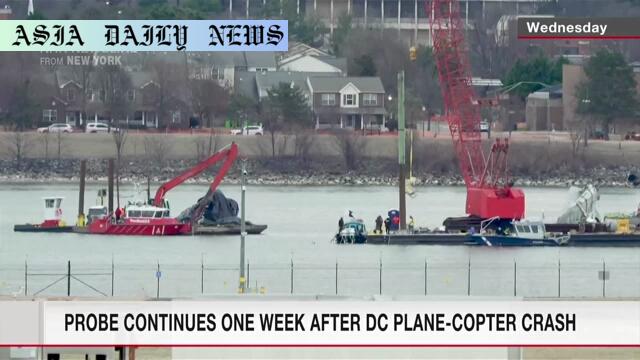Collision: US investigates deadly plane-helicopter accident, killing 67 and prompting safety and air traffic scrutiny.
Collision caused midair disaster near Washington, killing 67 people.
NTSB continues investigation, focusing on altitude violations & air traffic controller issues.
Efforts include recovering flight data, wreckage, and evaluating maintenance or procedural gaps.

An Overview of the Midair Collision
A devastating incident occurred near Ronald Reagan Washington National Airport on January 29, when a commercial passenger aircraft collided with a military helicopter. Tragically, the crash claimed the lives of all 67 individuals aboard the two aircraft. Among the victims were 28 young, aspiring figure skaters, accompanied by their families and coaches. This profound loss has brought national attention to aviation safety standards and regulatory oversight.
Details of the Incident
The collision happened when an American Airlines passenger jet, carrying 64 passengers and crew members, collided midair with a US Army helicopter. Preliminary investigations indicated that the helicopter was flying above its allowed altitude of 200 feet. Such a deviation raises serious questions about adherence to flight protocols and monitoring systems.
The collision caused both aircraft to crash into the Potomac River. Recovery teams promptly retrieved all 67 bodies, while efforts to salvage the wrecked aircraft have continued for more than a week following the tragedy. The incident highlights the severe risks posed by miscommunications or lapses in following air traffic regulations.
Ongoing Investigations
The US National Transportation Safety Board (NTSB) is heavily involved in uncovering the root causes of the accident. This includes examining the flight data and cockpit voice recorders from both aircraft. Additionally, the NTSB is evaluating the maintenance records and operational systems of the aircraft to ascertain whether there were mechanical flaws or procedural deficiencies.
Reports have emerged suggesting a shortage of air traffic controllers in the area. This potential shortfall is being scrutinized to determine its role, if any, in the tragedy. Air traffic controllers play a critical role in ensuring aircraft maintain safe distances, both horizontally and vertically, particularly in busy airspaces.
Human Error and Systemic Flaws
The preliminary report scheduled for release by the NTSB will provide an early look into the possible causes of the disaster; however, systemic issues such as human error, potential disregard for flight regulations, and the impact of external factors like air controller shortages are under consideration. The immense loss of life underscores the need for robust safety mechanisms and stringent compliance within aviation regulations.
The Broader Impacts
This tragic incident not only devastated families of the victims but also raised serious concerns about aviation safety. For the figure skating community, the loss of future talents serves as a poignant reminder of the fragility of life. The crash presents a call for innovation in safety protocols to prevent future occurrences, including enhanced training for air traffic personnel and improved in-flight communication systems.
Steps Moving Forward
Aviation bodies, including the Federal Aviation Administration (FAA) and the NTSB, face mounting pressures to address systemic flaws. Many experts advocate installing advanced collision-avoidance technologies that could act autonomously even if human operators fail. Additionally, prioritizing investments in recruiting and retaining air traffic controllers is critical.
The tragic collision near Washington brought the aviation community’s vulnerabilities into sharp focus. While steps towards recovery and reform are underway, lessons from this tragedy must serve to strengthen global transportation standards and ensure passenger safety is paramount.



Commentary
A Sobering Reminder of Aviation Risks
The midair collision near Washington serves as a stark reminder of the inherent dangers in aviation, even with sophisticated technologies and procedures in place. Tragedies like this highlight the fact that no system is infallible, and the human cost of errors or oversights in such a critical sector is devastating. The loss of 67 lives, including aspiring figure skaters and their mentors, renders this disaster even more heartbreaking for the loved ones left behind.
The Need for Systemic Improvements
As investigations progress, it’s essential to scrutinize every component of this accident—be it human error, equipment malfunctions, or lapses in broader systemic frameworks. The issues surrounding the helicopter’s elevation and potential air traffic controller shortages point to gaps that need immediate addressing. This tragedy calls not for blame but for accountability, learning, and vigilance.
Taking Lessons Forward
What stands out most is the urgent demand for stricter enforcement of aviation laws and updated training for personnel. This extends not just within the United States but globally, where air travel is only increasing. Incorporating advanced technologies that prevent altitude violations or improve communication could help minimize such disasters. For all the grief this event has brought, the silver lining must be the knowledge that steps will be taken to prevent another such catastrophe.
I hope the figure skating community and other affected groups receive the support they need to heal. As governments and aviation bodies conduct their reviews, let this tragedy mark a turning point for safer skies and better preventive measures for all.